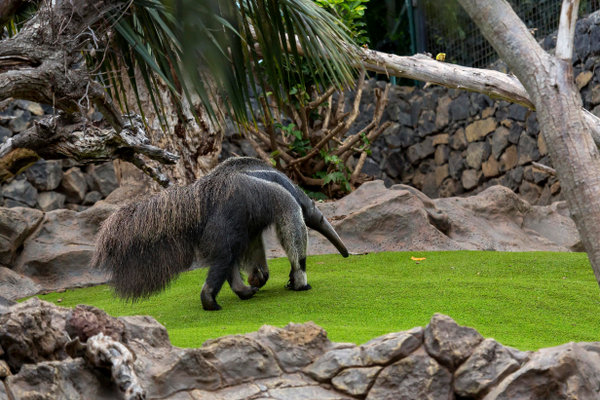Once again, and with our passion for Nature, we have reached out to a species that need the collaboration of all of us. In this case, Loro Parque has decided to give shelter the giant anteater and participate in its population growth. From here, we want to express that without your help and the visits we welcome every day, we could not protect all the species that need our urgent help.
Don’t you know the family of anteaters that live in Loro Parque yet?
A male anteater named “Hombrecito” and two beautiful females, “Cuñatai” and “Suanne”, are the only family of giant anteaters (Mirmecophaga tridactyla) in the Canary Islands, and they happily live in Loro Parque. This zoo participates in the European Endangered Species Programme (EEP) to conserve anteaters and promote adequate conditions for their survival and reproduction.
This species is categorised as ‘Vurnerable’ on the Red List of the International Union for Conservation of Nature (IUCN), due to the dramatic decline of living specimens. In their natural area, the particularity of their diet, the low rate of reproduction and the threats that degrade their habitat have been proved to be significant causes of their threatened status.
Did you know? In the last 10 years, anteaters’ population has dropped by 10%!
The extension of their habitat covers from Southern Mexico to Northeastern Argentina and is only present in the American continent. The largest concentrations are found in South America and the greater threats they suffer from are forest fires, which both destroy their natural environment and impede them to survive, as their fur is flammable – furthermore, their moves are too slow to be able to escape the fire. On the other hand, both hunting and sport hunting increases its vulnerability, as their fur and claws are used to tailor clothing products.
Let’s learn more about this particularly strong-looking yet particularly delicate species
The striking appearance of the giant anteater is mainly due to its long snout, which can measure up to 45 centimetres. The tongue in even longer: 50 centimetres covered with sticky saliva. The skull, ears and eyes and eyes are small though.
Anteaters can be both diurnal and nocturnal, depending on their needs. Although, most of anteaters near of cities make their daily activities by night. They usually curl up and rest in dense bushes, abandoned burrows and tall grass with their tail curved over its body to keep heat and camouflage.
This species is an excellent swimmer and he usually goes through broad rivers. Therefore, we have designed a lake in their facilities in Loro Parque with many fish species, where you can see them bathing in it.
Did you know that they can eat thousands of ants and termites, sticking out the tongue up to 150 times per minute? They can eat up to 30.000 larvae and ants.
Loro Parque will always fight for respect and preservation of biodiversity, and we encourage all of you to join us in this fascinating world. Get passionate about nature and protect our most important legacy! Let’s learn, together, how to love it and take steps in the right direction: the conservation of all the species of flora and fauna on this beautiful planet.
Thank you, Nature lovers! Let’s meet in our next post!











